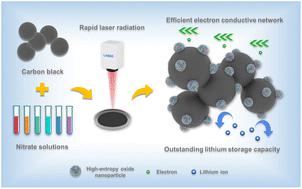当前位置:
X-MOL 学术
›
J. Mater. Chem. A
›
论文详情
Our official English website, www.x-mol.net, welcomes your feedback! (Note: you will need to create a separate account there.)
Rapid in situ growth of high-entropy oxide nanoparticles with reversible spinel structures for efficient Li storage
Journal of Materials Chemistry A ( IF 11.9 ) Pub Date : 2024-04-16 , DOI: 10.1039/d3ta08101j Siyu Zhu 1 , Wei Nong 1, 2 , Lim Jun Ji Nicholas 1 , Xun Cao 1 , Peilin Zhang 3 , Yu Lu 1 , Mingzhen Xiu 4 , Kang Huang 5 , Gang Wu 2 , Shuo-Wang Yang 2 , Junsheng Wu 5 , Zheng Liu 1 , Madhavi Srinivasan 1 , Kedar Hippalgaonkar 1, 6 , Yizhong Huang 1
Journal of Materials Chemistry A ( IF 11.9 ) Pub Date : 2024-04-16 , DOI: 10.1039/d3ta08101j Siyu Zhu 1 , Wei Nong 1, 2 , Lim Jun Ji Nicholas 1 , Xun Cao 1 , Peilin Zhang 3 , Yu Lu 1 , Mingzhen Xiu 4 , Kang Huang 5 , Gang Wu 2 , Shuo-Wang Yang 2 , Junsheng Wu 5 , Zheng Liu 1 , Madhavi Srinivasan 1 , Kedar Hippalgaonkar 1, 6 , Yizhong Huang 1
Affiliation

|
High-entropy oxides (HEOs) are considered promising electrode materials as they have great potential to provide much higher energy density and cyclability than their conventional electrode counterparts such as graphite. In the present work, nanostructured HEOs were fabricated on the surface of conductive carbon black using laser beam irradiation, which generally implements the rapid bottom-up carbothermal process. Furthermore, electrochemical performances of Co-free and Co-incorporated HEO nanoparticles in comparison with bulk-HEO counterparts were investigated. In particular, the Co-free (LiFeNiMnCuZn)3O4 nanoparticle electrode showed the best capability presenting both the highest cycling value of 866 mA h g−1 (100% capacity retention) after 800 cycles at 0.5 A g−1 and rate performances of 585 at 2.0 A g−1 and 436 mA h g−1 at 5.0 A g−1 without decay. The long cycling performance of Co-free HEOs could be derived from the reversible spinel structure, according to the in situ X-ray diffraction (XRD) results, as well as the strong thermal stability of high-entropy mixing phases, as indicated by a large positive decomposition enthalpy according to density functional theory (DFT) calculations. Additionally, the assembled full cell (LiFeNiMnCuZn)3O4‖LiNi0.6Co0.2Mn0.2O2 delivered a power density of 670 W h kg−1 with a high discharge voltage around 3.7 V based on the 0.1C discharge profile. As manifested by the DFT calculations, the low anode voltage of HEOs measured here is due to the electron-sufficient Zn, which favors the Ni2+/Ni3+ redox couple. This work is expected to provide a guideline for the development of advanced high-entropy nanostructured electrode materials for efficient batteries.
中文翻译:

具有可逆尖晶石结构的高熵氧化物纳米颗粒的快速原位生长用于高效锂存储
高熵氧化物(HEO)被认为是有前途的电极材料,因为它们具有比石墨等传统电极材料更高的能量密度和可循环性的巨大潜力。在目前的工作中,利用激光束照射在导电炭黑表面制备纳米结构HEO,通常实现快速自下而上的碳热过程。此外,还研究了无钴和掺钴 HEO 纳米粒子与块状 HEO 纳米粒子的电化学性能。特别是,无Co (LiFeNiMnCuZn) 3 O 4纳米颗粒电极表现出最佳性能,在0.5 A g -1下循环800次后呈现出最高循环值866 mA hg -1 (100%容量保持率)和倍率性能2.0 A g -1时为 585,5.0 A g -1时为 436 mA hg -1,无衰减。根据原位X 射线衍射(XRD)结果,无钴 HEO 的长循环性能可能源自可逆尖晶石结构,以及高熵混合相的强热稳定性(如根据密度泛函理论(DFT)计算的大正分解焓。此外,组装的全电池(LiFeNiMnCuZn)3 O 4 ‖LiNi 0.6 Co 0.2 Mn 0.2 O 2的功率密度为670 W h kg -1,基于0.1C放电曲线,放电电压约为3.7 V。 DFT 计算表明,此处测量的 HEO 的低阳极电压是由于电子充足的 Zn,有利于 Ni 2+ /Ni 3+氧化还原电对。这项工作有望为开发用于高效电池的先进高熵纳米结构电极材料提供指导。
更新日期:2024-04-16
中文翻译:

具有可逆尖晶石结构的高熵氧化物纳米颗粒的快速原位生长用于高效锂存储
高熵氧化物(HEO)被认为是有前途的电极材料,因为它们具有比石墨等传统电极材料更高的能量密度和可循环性的巨大潜力。在目前的工作中,利用激光束照射在导电炭黑表面制备纳米结构HEO,通常实现快速自下而上的碳热过程。此外,还研究了无钴和掺钴 HEO 纳米粒子与块状 HEO 纳米粒子的电化学性能。特别是,无Co (LiFeNiMnCuZn) 3 O 4纳米颗粒电极表现出最佳性能,在0.5 A g -1下循环800次后呈现出最高循环值866 mA hg -1 (100%容量保持率)和倍率性能2.0 A g -1时为 585,5.0 A g -1时为 436 mA hg -1,无衰减。根据原位X 射线衍射(XRD)结果,无钴 HEO 的长循环性能可能源自可逆尖晶石结构,以及高熵混合相的强热稳定性(如根据密度泛函理论(DFT)计算的大正分解焓。此外,组装的全电池(LiFeNiMnCuZn)3 O 4 ‖LiNi 0.6 Co 0.2 Mn 0.2 O 2的功率密度为670 W h kg -1,基于0.1C放电曲线,放电电压约为3.7 V。 DFT 计算表明,此处测量的 HEO 的低阳极电压是由于电子充足的 Zn,有利于 Ni 2+ /Ni 3+氧化还原电对。这项工作有望为开发用于高效电池的先进高熵纳米结构电极材料提供指导。



























 京公网安备 11010802027423号
京公网安备 11010802027423号